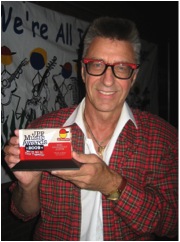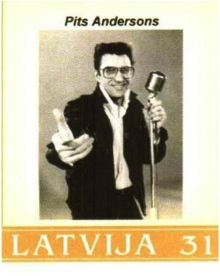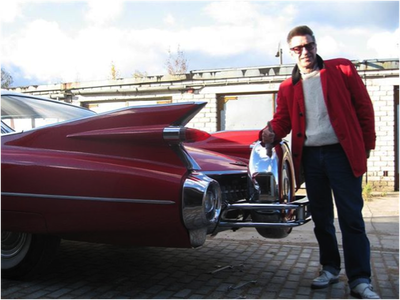Few rockers have experienced the harassment and harsh treatment, Pete Anderson endured for 15 years from the KGB. They opened and read all the mail he sent or he received. With each arrest, they would interrogate him for hours on end, never letting him know if and when they might release him.
Written by Douglas Yeager
BLESS YOU PETE. WE LOVE YOU!

PETE ANDERSON, who helped pioneer Soviet and Latvian Rock & Roll, while inspiring his country’s independence movement, has passed away after a three-year hard-fought battle with cancer. Read the official announcement from Public Broadcasting of Latvia HERE
Pete is a central figure in FREE TO ROCK and was a key inspiration for making the film. In the film, we have governmental leaders, such as Mikhail Gorbachev, Jimmy Carter, Latvia’s president Vike-Freiberga, NATO’s Deputy Secretary General Vershbow, Latvian Ambassador Ojar Kalnins, Hungarian Ambassador Andras Simonyi and former KGB General Oleg Kalugin, all speaking in support of this thesis, but it is the pioneer rockers, like Pete Anderson, who, in his case, began performing the forbidden Rock & Roll in public in 1959, then fought a long and brutal battle with the KGB for more than thirty years, that allows the viewer of the film to feel the real, compelling, believable and personal storylines of the Iron Curtain rockers from their own voices
Pete is a central figure in FREE TO ROCK and was a key inspiration for making the film. In the film, we have governmental leaders, such as Mikhail Gorbachev, Jimmy Carter, Latvia’s president Vike-Freiberga, NATO’s Deputy Secretary General Vershbow, Latvian Ambassador Ojar Kalnins, Hungarian Ambassador Andras Simonyi and former KGB General Oleg Kalugin, all speaking in support of this thesis, but it is the pioneer rockers, like Pete Anderson, who, in his case, began performing the forbidden Rock & Roll in public in 1959, then fought a long and brutal battle with the KGB for more than thirty years, that allows the viewer of the film to feel the real, compelling, believable and personal storylines of the Iron Curtain rockers from their own voices
Thankfully, during Pete’s days with us on earth, he not only received adulation from hundreds of thousands of fans and accolades in Europe for his performances and recordings, but he was also honored in Nashville seven years ago at the International Rockabilly Convention, with the “Best Rockabilly Album of the Year.”
What Pete’s fans outside of Latvia may not have known is that he is also considered a real Hero of his country's liberation. He had been honored by Latvia with its highest governmental honors, not only for his contributions to the arts, but for his decades-long fight against the communist system and the KGB during the Cold War. His steadfast determination to preserve the right to sing and perform the music he loved, not only provided the fuel for Latvian teens to rebel, it inspired them to rebel against the totalitarian system in their fight for Independence and liberation from the Soviet Union and its occupation of their country. He was awarded the highest civilian honor his country can bestow on a citizen, the Order of the Three Stars, and his face and name are found on a Latvian Postage Stamp.
What Pete’s fans outside of Latvia may not have known is that he is also considered a real Hero of his country's liberation. He had been honored by Latvia with its highest governmental honors, not only for his contributions to the arts, but for his decades-long fight against the communist system and the KGB during the Cold War. His steadfast determination to preserve the right to sing and perform the music he loved, not only provided the fuel for Latvian teens to rebel, it inspired them to rebel against the totalitarian system in their fight for Independence and liberation from the Soviet Union and its occupation of their country. He was awarded the highest civilian honor his country can bestow on a citizen, the Order of the Three Stars, and his face and name are found on a Latvian Postage Stamp.
The last time Pete performed was during a series of events in Riga, Latvia last March, when the Latvian government, the U.S. Embassy and the Foundation for an Open Society screened FREE TO ROCK and produced a series of associated events. My original co-producer/partner Nick Binkley (with whom I began the project in Latvia 10 ½ years ago), and I flew to Riga for this event. Upon arrival, we took a car out to see Pete and his beloved wife and partner Anna at their new home outside of Riga the day before the events. We knew he was quite ill and had been fighting a long battle with cancer. We had been pledged to secrecy with him, not to tell anyone, as he feared that promoters would stop booking him for concerts.
We arrived to Pete and Anna’s lovely home, which they had been rehabbing for two years, and was newly finished. It was wonderful to see our old friends, and to give Pete a loving embrace -- though gently, as he was in considerable pain. It was painful for him to walk and he couldn't use his left arm and shoulder which surrounded the tennis ball-sized tumor in the left side of his chest. He was grimacing even when talking or making the smallest of movements. Yet, despite his affliction, Pete wanted us to take a tour of his home, of which he was so proud. He first took us upstairs to his office, where he proudly showed us his governmental honors and awards, in addition to the first album he was ever allowed to record after his many years of KGB induced exile from Rock & Roll. This album, which the State monopoly record label Melodiya put out after Gorby came to power, was full of Rock & Roll classics. He showed us the plaque Melodiya gave him after selling 10 million copies. Of course, Nick and I were aware, and acknowledged with Pete, that Melodiya never paid royalties to any artists (Pete) or to the publishers/ songwriters of any foreign songs. Pete then wanted us to walk outside in the cold air with him, to see his garage where he worked on his cars – his other favorite passion. We immediately noticed that his prized 1959 antique, mint condition red Cadillac, wasn't there. He smiled and explained that it was being kept in a temperature regulated storage garage in town.
We arrived to Pete and Anna’s lovely home, which they had been rehabbing for two years, and was newly finished. It was wonderful to see our old friends, and to give Pete a loving embrace -- though gently, as he was in considerable pain. It was painful for him to walk and he couldn't use his left arm and shoulder which surrounded the tennis ball-sized tumor in the left side of his chest. He was grimacing even when talking or making the smallest of movements. Yet, despite his affliction, Pete wanted us to take a tour of his home, of which he was so proud. He first took us upstairs to his office, where he proudly showed us his governmental honors and awards, in addition to the first album he was ever allowed to record after his many years of KGB induced exile from Rock & Roll. This album, which the State monopoly record label Melodiya put out after Gorby came to power, was full of Rock & Roll classics. He showed us the plaque Melodiya gave him after selling 10 million copies. Of course, Nick and I were aware, and acknowledged with Pete, that Melodiya never paid royalties to any artists (Pete) or to the publishers/ songwriters of any foreign songs. Pete then wanted us to walk outside in the cold air with him, to see his garage where he worked on his cars – his other favorite passion. We immediately noticed that his prized 1959 antique, mint condition red Cadillac, wasn't there. He smiled and explained that it was being kept in a temperature regulated storage garage in town.
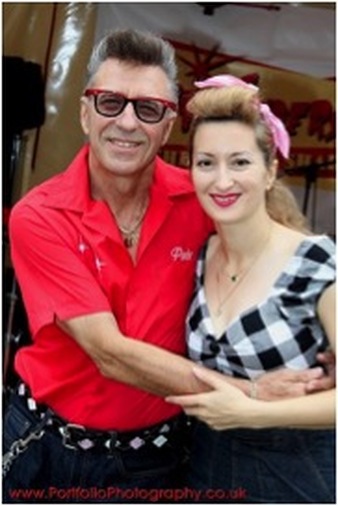
Once back in his living room, Anna graciously had some tea and cookies waiting for us. As I sipped my tea, I gingerly asked Pete how he would be able to perform the next night after the film, considering his physical condition? He told us that he planned to take a lot of pain killers and only be on stage to sing half the songs. He continued, saying, “I won’t be playing the guitar….it is too painful to hold and I can’t strum it….and I’ll let the kids perform the rest of the show without me. “ He then reminded Nick and I that we couldn’t let anyone in Latvia know that he was ill. His wife Anna, a career chemist, had left her job some years back to become an integral part of the band - Pete Anderson & The Swamp Shakers, as the beautiful, sexy and very talented upright bass performer. As she was no longer earning a living as a chemist, Pete was very concerned about the family finances and keeping their new home if the band wasn’t working. His medical insurance wouldn’t cover the type of modern cancer treatments his particular lung cancer required, and he was extremely concerned about leaving Anna a mountain of debts because of his illness. I told him, how in America, when a beloved musicians was confronted with similar situations, a benefit concert with all of the artist’s friends performing, would be produced, so as to raise all the funds for the treatments. I told him that I would help organize it in Riga. He refused….still concerned that all his bookings would dry up if word got out. He already had tours in Europe and Australia already lined up.
Upon walking out of their home to the car -- our heads hanging low in stunned silence, Nick and I looked over at each other in disbelief, certain that he would not even be able to mount the stage for tomorrow’s concert. . . . . knowing that our friend didn’t have long to live.
Later that evening, we were surprised, when Pete showed up at the lovely residence of United States Charge d’Affaires (acting Ambassador) of the U.S. Embassy, Sharon Hudson-Dean and her husband, for a wonderful homey dinner. The other guests that evening, included the Latvian Minister of Culture Dace Melbarde, our old friend Ojars Kalnins, who is the Chairman of the Foreign Affairs Committee of the Latvian Parliament, Ieva Morica (Latvian Executive Director of the Foundation for an Open Society), Dita Rietuma (Director of the National Film Center of Latvia), Paul Raudseps (noted Latvian cultural journalist) and Kathy Giles-Diaz of the U.S. Embassy. Though Pete was quiet and subdued that evening – a result of pain killers-- he was able to show no signs of illness to the attending guests.
Upon walking out of their home to the car -- our heads hanging low in stunned silence, Nick and I looked over at each other in disbelief, certain that he would not even be able to mount the stage for tomorrow’s concert. . . . . knowing that our friend didn’t have long to live.
Later that evening, we were surprised, when Pete showed up at the lovely residence of United States Charge d’Affaires (acting Ambassador) of the U.S. Embassy, Sharon Hudson-Dean and her husband, for a wonderful homey dinner. The other guests that evening, included the Latvian Minister of Culture Dace Melbarde, our old friend Ojars Kalnins, who is the Chairman of the Foreign Affairs Committee of the Latvian Parliament, Ieva Morica (Latvian Executive Director of the Foundation for an Open Society), Dita Rietuma (Director of the National Film Center of Latvia), Paul Raudseps (noted Latvian cultural journalist) and Kathy Giles-Diaz of the U.S. Embassy. Though Pete was quiet and subdued that evening – a result of pain killers-- he was able to show no signs of illness to the attending guests.
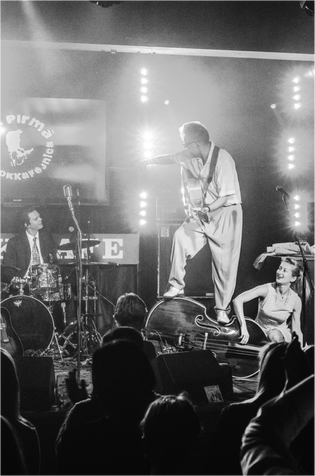
The following night at the screening, which was presented in Riga’s historic Splendid Place Theatre, and was attended by hundreds of government officials, corporate leaders, foreign diplomats, U.S. State Department officials, and fans of Rock & Roll, Pete once again amazed us. He was handsomely dressed, said hello to the dignitaries as he entered, and then came and sat beside Nick and me in the theatre. During the speeches preceding the film by Cultural Minister Melbarde, Sharon Hudson-Dean and Ieva Morica, I could hear Pete moaning with pain in his seat. Yet, when the film finished, he pulled himself together, got up and mounted the stairs to the stage with Nick, Ojars, and I, and participated in our panel discussion with Paul Raudseps. The applause at the film’s conclusion had been long and enthusiastic, and no one in the capacity overflowed theatre left during the 40 minute panel discussion. And Pete was in full control when he spoke eloquently about the urgent need for cultural diplomacy more today than ever, while noting that 80,000 Russian troops were positioned on their eastern border as the U.S. Navy had just unloaded hundreds of Marines and tanks at the port Riga to begin maneuvers with the Latvian military.
After the panel discussion concluded, Pete proceeded to join us at the reception upstairs in the theatre. He cordially greeted everyone, posed for photos, and made an early exit so that he and his band could do a sound check for the concert.
After the reception, Nick and I walked with our new friend, Ieva Morica, over to the venue where Pete was scheduled to perform. We ordered some drinks while waiting for the show. Quite a bit of time passed while we were socializing with everyone. No one else knew of Pete’s condition, but Nick and I were feeling concerned and nervous as our watches reminded us that it was 20 minutes past the time when the band was supposed to hit the stage. . . . .
Then, all of sudden, Pete came out of nowhere, jumped on the stage with the guitar around his neck….with his wife and band mates following right behind him. He looked as if he was 40 years old and full of vim and vinegar!
Pete stormed through twenty songs in the ensuing 90 minutes, singing and playing his guitar with the physically demonstrative verve of a young Elvis – as if this would be his last performance ever! The wild crowd demanded several long encores.
The concert culminated with Pete jumping on top of the side of the upright bass. now prone on the floor (and being played by his wife Anna on her knees). And, as the band played their thunderous last chord, Pete threw his arms in the air in a triumphant smile and expression of victory.
Without a doubt it was the best performance Nick and I had ever seen Pete give. Fatefully, it would be Pete’s last performance.
After the panel discussion concluded, Pete proceeded to join us at the reception upstairs in the theatre. He cordially greeted everyone, posed for photos, and made an early exit so that he and his band could do a sound check for the concert.
After the reception, Nick and I walked with our new friend, Ieva Morica, over to the venue where Pete was scheduled to perform. We ordered some drinks while waiting for the show. Quite a bit of time passed while we were socializing with everyone. No one else knew of Pete’s condition, but Nick and I were feeling concerned and nervous as our watches reminded us that it was 20 minutes past the time when the band was supposed to hit the stage. . . . .
Then, all of sudden, Pete came out of nowhere, jumped on the stage with the guitar around his neck….with his wife and band mates following right behind him. He looked as if he was 40 years old and full of vim and vinegar!
Pete stormed through twenty songs in the ensuing 90 minutes, singing and playing his guitar with the physically demonstrative verve of a young Elvis – as if this would be his last performance ever! The wild crowd demanded several long encores.
The concert culminated with Pete jumping on top of the side of the upright bass. now prone on the floor (and being played by his wife Anna on her knees). And, as the band played their thunderous last chord, Pete threw his arms in the air in a triumphant smile and expression of victory.
Without a doubt it was the best performance Nick and I had ever seen Pete give. Fatefully, it would be Pete’s last performance.
Recalling Filming with Pete
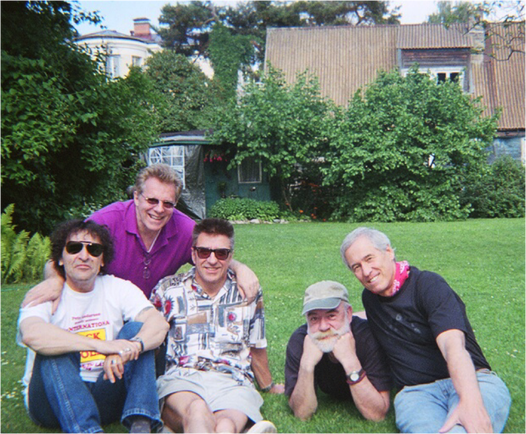
When Nick, Valery Saifudinov and I flew to Riga in June 2005 to explore the story of Rock & Roll's contribution to the dissolution of the communist system in Europe, we knew it would be very difficult -- maybe impossible - to prove a thesis that rock music and its culture truly had been a significant contributing factor to the collapse of the system. Valery was a pioneer Soviet rocker. In the book, BACK IN THE USSR, he is credited with forming the first Soviet rock band. For the past twenty years, he and Nick had been operating a recording studio in San Diego. On this adventure back to Latvia, he would be our guide and translator when needed, and navigate us through the people, culture and places in Latvia where we were going to begin filming our interviews and making our exploration.
Nick had heard all of Valery’s harrowing stories of trying to perform Rock & Roll -- a forbidden music in the USSR -- back in the `50s – 70s. Meanwhile, I had just completed weeks of research on the situation of Rock vs. the Kremlin during the Cold War in the USSR. So, we were semi-well-informed on the subject. We thought there was a good possibility that we would be able to at least satisfy ourselves that the thesis was sound. But, we knew that in order to convince the world – and its academics and political leaders, we would have to document overwhelming evidence and gain support from major voices to make it accepted by the masses. If we couldn’t gain some hard evidence during this trip, we would chalk it off as a fun, eleven-day adventure. A fascinating vacation.
The first person Valery wanted us to interview, was his childhood friend Pits “Pete” Anderson, who along with Valery, pioneered rock music in Latvia and the USSR.
In order to fully understand the conflict between Rock & Roll and the Kremlin, it’s important to understand the importance of Rock & Roll in Latvia, and the historic importance of Pete and Valery to that story.
Latvia was the first Soviet republic to be infected with the rock virus, in large part because of its location, culture and historical politics. Soviet Latvia’s capital city Riga, was the largest warm weather port in the USSR, and received thousands of merchant seaman from neutral ports who would smuggle in forbidden fruit in the 1950s, such as blue jeans, chewing gum, and the most dangerous contraband of them all -- American Rock & Roll records. Situated on the Baltic Sea, across from Finland and Sweden, it was very difficult for the Soviet radio jamming stations to block the airwaves blasting into Riga with the sounds of electric guitars and wild drums played by Bill Haley, Elvis, Little Richard, et al. Culturally, unlike most Soviet citizens, who aligned themselves with either Slavic or Asian cultures, the people in the Baltic States of Estonia, Latvia and Lithuania embraced European and Western cultures and its musical influences. And, of great significance, since the Soviets began an occupation of the Baltic States in 1940, the indigenous people of this region hated their Russian occupiers, and Rock and Roll became a fuel for their rebellion.
Eventually, over the coming decade, the less rebellious and more harmony-laced vocal sounds and classically influenced arrangements of the Beatles swept into Moscow and other republics, while resonating with ethnic Russians in its similarities to the historic cultural music of Russia. This music was like a breath of fresh air for their youth, but not necessarily a source to cause a rebellion against the communist system and the totalitarian regime controlling it…. as had been the case a decade earlier with the teenagers living in the Baltic States and in Eastern Europe, who fervently embraced `50s American Rock & Roll as the Sound of Freedom.
The original American music art form of Rock & Roll entered the Soviet Union through the port of Riga in the mid-1950s, and Pete Anderson and Valery Saifudinov were the first young rockers to be infected with the sound. And, Pete and Valery were the first Rock & Roll Rebels in the Soviet Union.
Nick and I arrived at Pete’s home for our first interview with our cameraman Raivo Carro. We were immediately riveted to our seats, as Pete, surrounded by posters of Ricky Nelson, Little Richard and Jerry Lee Lewis, started telling us his life story. Since performing Little Richard’s “Long Tall Sally” with a college jazz band in 1959, he was kicked out of school, and eventually endured twelve arrests by the KGB over the next fifteen years for performing the music that became the passion of his life.
Nick had heard all of Valery’s harrowing stories of trying to perform Rock & Roll -- a forbidden music in the USSR -- back in the `50s – 70s. Meanwhile, I had just completed weeks of research on the situation of Rock vs. the Kremlin during the Cold War in the USSR. So, we were semi-well-informed on the subject. We thought there was a good possibility that we would be able to at least satisfy ourselves that the thesis was sound. But, we knew that in order to convince the world – and its academics and political leaders, we would have to document overwhelming evidence and gain support from major voices to make it accepted by the masses. If we couldn’t gain some hard evidence during this trip, we would chalk it off as a fun, eleven-day adventure. A fascinating vacation.
The first person Valery wanted us to interview, was his childhood friend Pits “Pete” Anderson, who along with Valery, pioneered rock music in Latvia and the USSR.
In order to fully understand the conflict between Rock & Roll and the Kremlin, it’s important to understand the importance of Rock & Roll in Latvia, and the historic importance of Pete and Valery to that story.
Latvia was the first Soviet republic to be infected with the rock virus, in large part because of its location, culture and historical politics. Soviet Latvia’s capital city Riga, was the largest warm weather port in the USSR, and received thousands of merchant seaman from neutral ports who would smuggle in forbidden fruit in the 1950s, such as blue jeans, chewing gum, and the most dangerous contraband of them all -- American Rock & Roll records. Situated on the Baltic Sea, across from Finland and Sweden, it was very difficult for the Soviet radio jamming stations to block the airwaves blasting into Riga with the sounds of electric guitars and wild drums played by Bill Haley, Elvis, Little Richard, et al. Culturally, unlike most Soviet citizens, who aligned themselves with either Slavic or Asian cultures, the people in the Baltic States of Estonia, Latvia and Lithuania embraced European and Western cultures and its musical influences. And, of great significance, since the Soviets began an occupation of the Baltic States in 1940, the indigenous people of this region hated their Russian occupiers, and Rock and Roll became a fuel for their rebellion.
Eventually, over the coming decade, the less rebellious and more harmony-laced vocal sounds and classically influenced arrangements of the Beatles swept into Moscow and other republics, while resonating with ethnic Russians in its similarities to the historic cultural music of Russia. This music was like a breath of fresh air for their youth, but not necessarily a source to cause a rebellion against the communist system and the totalitarian regime controlling it…. as had been the case a decade earlier with the teenagers living in the Baltic States and in Eastern Europe, who fervently embraced `50s American Rock & Roll as the Sound of Freedom.
The original American music art form of Rock & Roll entered the Soviet Union through the port of Riga in the mid-1950s, and Pete Anderson and Valery Saifudinov were the first young rockers to be infected with the sound. And, Pete and Valery were the first Rock & Roll Rebels in the Soviet Union.
Nick and I arrived at Pete’s home for our first interview with our cameraman Raivo Carro. We were immediately riveted to our seats, as Pete, surrounded by posters of Ricky Nelson, Little Richard and Jerry Lee Lewis, started telling us his life story. Since performing Little Richard’s “Long Tall Sally” with a college jazz band in 1959, he was kicked out of school, and eventually endured twelve arrests by the KGB over the next fifteen years for performing the music that became the passion of his life.
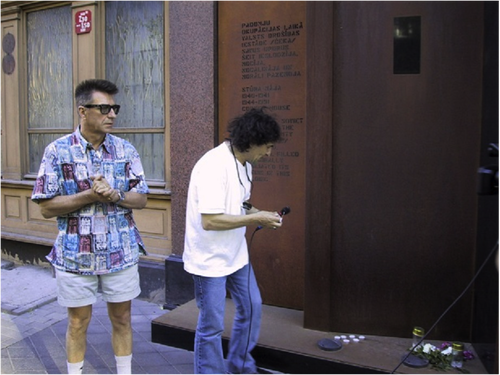
Few rockers have experienced the harassment and harsh treatment, Pete Anderson endured for fifteen-years from the KGB. They opened and read all the mail he sent or he received. With each arrest, they would interrogate him for hours on end, never letting him know if and when they might release him. When in Moscow, he was arrested him and put in prison for secretly meeting with the U.S. Embassy’s Cultural Attache Donald Sheehan, who had given him American record albums. In 1972, after he had been invited to perform at London’s Wembley Stadium, and to share the bill with his idols, Little Richard, Jerry Lee Lewis, Chuck Berry and The Original Comets, he applied for a visa to travel to England for the concert. The next day, the KGB arrested him, grilled him for hours, and before releasing him, threatened to kill his daughter if he didn’t give up Rock & Roll With his family’s life in peril, he had to give up his passion and career for fourteen long years. However, one night in 1974, while in a state of depression and longing to hear the music he loved, Pete ventured out of his countryside abode into the city of Riga, to the College Academy of Arts, where college students had been given a permit to perform a rock concert to their fellow students. When the band on stage saw Pete standing against the wall on the side of the auditorium, they yelled in the microphone for him to come up and sing a song. The crowd exploded with excitement. He first shook his head, “No.” But with the crowd chanting his name and urging him on, he acted on impulse, mounted the stage and sang one of his `50s classics. As the students wildly applauded and begged for more, he had a panic attack….. realizing what he had just done! He immediately jumped off the stage, ran out of the auditorium, out the building’s main doors, and down the steps to the walk way. Suddenly, he was attacked by KGB officers who knocked him to the ground and proceeded to kick him mercilessly until he passed out in a pool of blood. Some students found him and rushed him to the hospital, where he fought for his life for two weeks. Upon his release, another threat was made on his family’s life.
It wouldn’t be until Mikhail Gorbachev came to power, and loosened the reigns on Rock & Roll, that Pete Anderson would be allowed once again to perform his Rock & Roll.
Finally, in 1988, the Soviet government allowed Pete to make his first album, and his first music video, “Good Rockin’ Tonight.” The song, written in 1947 by Roy Brown, became a major R&B hit for Wynonie Harris in 1948. Pete considered this song to be one of the first pillars for the sound of Rock & Roll. And in 1954, it became the second single release of Elvis Presley.
It wouldn’t be until Mikhail Gorbachev came to power, and loosened the reigns on Rock & Roll, that Pete Anderson would be allowed once again to perform his Rock & Roll.
Finally, in 1988, the Soviet government allowed Pete to make his first album, and his first music video, “Good Rockin’ Tonight.” The song, written in 1947 by Roy Brown, became a major R&B hit for Wynonie Harris in 1948. Pete considered this song to be one of the first pillars for the sound of Rock & Roll. And in 1954, it became the second single release of Elvis Presley.
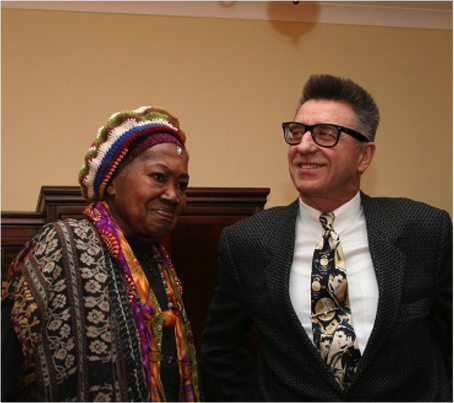
During our very first of many interviews with Pete, Nick and I immediately realized that if the Kremlin felt so threatened by a guy in Latvia singing Ricky Nelson and Fats Domino songs that they would go to the extreme lengths of threatening to kill his children in order to stop him, then we knew we had a powerful story in our hands, a story that needed to be told. The Kremlin didn’t only feel threatened by this young rocker in Soviet Latvia, they were fearful and felt threatened by the American cultural onslaught of Rock & Roll which they perceived to be a new weapon in the arsenal of the CIA and NATO. We also learned that day, that despite being barred from further education at the age 14, Pete was a highly self-educated man who spoke eleven languages, and could interact with rockers, academics and politicians alike.
The following day, Pete called the home phone of one of his ardent fans - the former Latvian Defense Minister, and asked if he could arrange for us to bring our film crew into the former KGB dungeons that had been chained shut and not been opened to the public since the Soviets left in the middle of the night in 1991!
The building located above the dungeon, had been the KGB Headquarters from 1940-1941, and again from 1943 – 1991. From 1941 to 1943, it was Germany’s Gestapo Headquarters. Today, it houses the offices of the Latvian State Police Intelligence Department. No rehabbing or painting has been applied to the building’s interior or exterior since the Soviets left. After we arrived and passed through the same security gates as Pete had experienced decades earlier, he introduced us to his friend (and fan), the Deputy-Director of Latvia’s Organized Crime Department, Lega Seruda. She gave us a tour of the rooms where Pete had once been interrogated; and then, accompanied by two armed guards, led us outside to the courtyard, where thousands of Latvians deemed untrustworthy by the KGB and Gestapo had once been hung. We continued walking as he then led us down some stops to the doors of the dungeon, where thousands more had been tortured, shot and electrocuted. The guards took the locks off of the chains, opened the doors, and we began descending down a long, narrow, circular and dark stone stairway. There was no electricity in the dungeon, but we did have flashlights. None of our guides had ever been down into these death chambers. It was a chilling and haunting experience. Nothing had been touched since the Soviets left in the middle of the night. Not the paper documents, the bullet holes in the walls and cell doors, the platforms for the electrocutions, or the thousands of spent bullet shells left in open boxes on the floors.
Afterwards, we interviewed Pete outside the building, in front of the Memorial built to honor all those that perished at the hands of the Russians. He was still numb, after reliving his experiences with the KGB and thinking of the thousands of Latvians who died behind those walls.
The next day, via the help of another of Pete’s friends, former Member of Parliament Roland Blezurs, we were soon coordinating film interviews with President Vike-Freiberga and with Ojars Kalnins, former Latvian Ambassador to the United States.
In 2006, Nick and I returned to Latvia, with the folk/blues legend and civil rights icon ODETTA, who was scheduled to speak at a Human Rights Convention, give a concert, and participate in other special events arranged for her. Pete and Odetta had first become friends in 1975, when she made a historic tour of the Soviet Union. As an outlawed and blacklisted rocker/activist, it wasn’t easy for Pete to meet the Voice of the Civil Rights Movement. However, once overcoming the obstacles, Pete travelled with Odetta from Latvia to Lithuania, while making cunning maneuvers to avoid the KGB.
During our 2006 trip to Riga with Odetta, Pete arranged for us to meet additional subjects whom we would interview; and he arranging for Viss Notiek, Latvian television’s format version of our 60 Minutes, to do three segments for future broadcasts: One with Nick and I, discussing the making of the film; one with Odetta, discussing her life, career, and purpose for returning to Latvia; and one with Pete, discussing his life and career.
The following day, Pete called the home phone of one of his ardent fans - the former Latvian Defense Minister, and asked if he could arrange for us to bring our film crew into the former KGB dungeons that had been chained shut and not been opened to the public since the Soviets left in the middle of the night in 1991!
The building located above the dungeon, had been the KGB Headquarters from 1940-1941, and again from 1943 – 1991. From 1941 to 1943, it was Germany’s Gestapo Headquarters. Today, it houses the offices of the Latvian State Police Intelligence Department. No rehabbing or painting has been applied to the building’s interior or exterior since the Soviets left. After we arrived and passed through the same security gates as Pete had experienced decades earlier, he introduced us to his friend (and fan), the Deputy-Director of Latvia’s Organized Crime Department, Lega Seruda. She gave us a tour of the rooms where Pete had once been interrogated; and then, accompanied by two armed guards, led us outside to the courtyard, where thousands of Latvians deemed untrustworthy by the KGB and Gestapo had once been hung. We continued walking as he then led us down some stops to the doors of the dungeon, where thousands more had been tortured, shot and electrocuted. The guards took the locks off of the chains, opened the doors, and we began descending down a long, narrow, circular and dark stone stairway. There was no electricity in the dungeon, but we did have flashlights. None of our guides had ever been down into these death chambers. It was a chilling and haunting experience. Nothing had been touched since the Soviets left in the middle of the night. Not the paper documents, the bullet holes in the walls and cell doors, the platforms for the electrocutions, or the thousands of spent bullet shells left in open boxes on the floors.
Afterwards, we interviewed Pete outside the building, in front of the Memorial built to honor all those that perished at the hands of the Russians. He was still numb, after reliving his experiences with the KGB and thinking of the thousands of Latvians who died behind those walls.
The next day, via the help of another of Pete’s friends, former Member of Parliament Roland Blezurs, we were soon coordinating film interviews with President Vike-Freiberga and with Ojars Kalnins, former Latvian Ambassador to the United States.
In 2006, Nick and I returned to Latvia, with the folk/blues legend and civil rights icon ODETTA, who was scheduled to speak at a Human Rights Convention, give a concert, and participate in other special events arranged for her. Pete and Odetta had first become friends in 1975, when she made a historic tour of the Soviet Union. As an outlawed and blacklisted rocker/activist, it wasn’t easy for Pete to meet the Voice of the Civil Rights Movement. However, once overcoming the obstacles, Pete travelled with Odetta from Latvia to Lithuania, while making cunning maneuvers to avoid the KGB.
During our 2006 trip to Riga with Odetta, Pete arranged for us to meet additional subjects whom we would interview; and he arranging for Viss Notiek, Latvian television’s format version of our 60 Minutes, to do three segments for future broadcasts: One with Nick and I, discussing the making of the film; one with Odetta, discussing her life, career, and purpose for returning to Latvia; and one with Pete, discussing his life and career.
We Say Goodbye
Happily, Pete’s now in Rock & Roll Heaven with his heroes, Big Joe Turner, Bill Haley, Elvis Presley, Carl Perkins, Ricky Nelson, Eddie Cochrane, Gene Vincent, Louie Prima, and all of the less publicized Black artists who created the genre – most of whom are unknown to us, but Pete knew and revered as Gods. He could passionately tell you their entire life stories, in addition to the name, number and label of each of their record releases. Pioneers, such as Louie Jordan, Wynonie Harris, Wild Bill Moore, Jackie Brentson with Ike Turner, and Goree Carter. I can just see him how having a ball, and being warmly welcomed and accepted by his mentors as a true member of their band!
Pete Anderson gave us the meat, the inspiration, passion and boost to go on and make FREE TO ROCK – a difficult, complex and costly film that took 10 ½ long years to complete. It certainly became a labor of love. And, in the process, Pete became our dear friend.
Farewell old friend. May you freely play the music you love forever and ever. Your music will never die, and the joy, passion and adventure you brought to our lives will always be with us.
Pete’s funeral is being held Saturday, January 23rd at Riga’s Splendid Palace Theatre, where all of his fans can come and pay respects to their “King of Rock & Roll.” It is the same theatre where FREE TO ROCK was screened last March. After the funeral, his wake will be held at the Rock Café, the large club and restaurant in the old city, where Pete played his final concert following the film. It seems fitting. . . .
Bless you Pete.
We Love You!
Doug, Nick and the FREE TO ROCK Team
Pete Anderson gave us the meat, the inspiration, passion and boost to go on and make FREE TO ROCK – a difficult, complex and costly film that took 10 ½ long years to complete. It certainly became a labor of love. And, in the process, Pete became our dear friend.
Farewell old friend. May you freely play the music you love forever and ever. Your music will never die, and the joy, passion and adventure you brought to our lives will always be with us.
Pete’s funeral is being held Saturday, January 23rd at Riga’s Splendid Palace Theatre, where all of his fans can come and pay respects to their “King of Rock & Roll.” It is the same theatre where FREE TO ROCK was screened last March. After the funeral, his wake will be held at the Rock Café, the large club and restaurant in the old city, where Pete played his final concert following the film. It seems fitting. . . .
Bless you Pete.
We Love You!
Doug, Nick and the FREE TO ROCK Team
|
|
|
